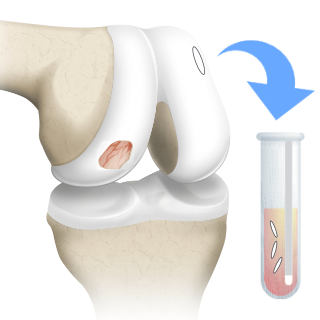mACI is an abbreviation of 'matrix-induced autologous chondrocyte implantation', which means the implantation back into a patient of their own cartilage cells which have been seeded onto a matrix during laboratory processing.
 Page updated May 2024 by Dr Sheila Strover (Clinical Editor)
Page updated May 2024 by Dr Sheila Strover (Clinical Editor)

Technique of mACI
Damaged joint cartilage does not heal well on its own.
Procedures of cartilage repair have been developed to fill in deep defects with more viable cartilage material.
-
Quote from peer-reviewed paper:
"....Several critical factors may determine clinical outcomes and quality of repair tissue after MACI procedure in patients, including 1) successful chondrocyte culture and expansion, 2) technical proficiency of the surgeons...., 3) patient cooperation and compliance in all aspects of the preoperative and postoperative programs...., and 4) timely progression of weight-bearing and adjunct exercises and postoperative rehabilitation...."
Citation: Zhang Z, Zhong X, Ji H, Tang Z, Bai J, Yao M, Hou J, Zheng M, Wood DJ, Sun J, Zhou SF, Liu A. Matrix-induced autologous chondrocyte implantation for the treatment of chondral defects of the knees in Chinese patients. Drug Des Devel Ther. 2014 Dec 5;8:2439-48. doi: 10.2147/DDDT.S71356. PMID: 25525334; PMCID: PMC4266264.
Comparing mACI and ACI
ACI is an earlier cartilage repair procedure, and mACI was developed from it and is more sophisticated.
ACI is a two-stage procedure, where chondrocytes are cultured and then are injected into the defect behind a 'curtain' of connective tissue harvested from adjacent bone and which has been sutured over the defect to contain the new cells.
Comparing mACI and AMIC
-
Quote from peer-reviewed paper:
"....a partially autologous fibrin glue may be manufactured by centrifuging a blood sample from the patient and mixing the yielded thrombin with allogenic fibrinogen...."
Citation: Benthien JP, Behrens P. Autologous Matrix-Induced Chondrogenesis (AMIC): Combining Microfracturing and a Collagen I/III Matrix for Articular Cartilage Resurfacing. Cartilage. 2010 Jan;1(1):65-8. doi: 10.1177/1947603509360044. PMID: 26069536; PMCID: PMC4440611.
-
Quote from peer-reviewed paper:
"AMIC may provide better outcomes than mACI for chondral defects of the knee."
Citation: Migliorini F, Eschweiler J, Götze C, Driessen A, Tingart M, Maffulli N. Matrix-induced autologous chondrocyte implantation (mACI) versus autologous matrix-induced chondrogenesis (AMIC) for chondral defects of the knee: a systematic review. Br Med Bull. 2022 Mar 21;141(1):47-59. doi: 10.1093/bmb/ldac004. PMID: 35175354; PMCID: PMC9351375.
Forum discussions
- cartilage damage: cartiform vs maci vs allograft
Patients compare and contrast the various cartilage repair procedures.
- Right at the start! ACI/MACI. Dr Briggs.
A very active patient walks us through his decisions and procedures for mACI.
See also -
- ACI
- Matrix-induced autologous chondrocyte implant
- AMIC
- Nanofracture Autologous Matrix-Induced Chondrogenesis
 2011 - MACI discussion - by Prof Adrian Wilson (Knee Surgeon)
2011 - MACI discussion - by Prof Adrian Wilson (Knee Surgeon)
